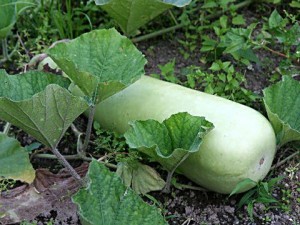 The calabash or bottle gourd (Lagenaria siceraria), popularly known as “Upo” in the Philippines, is a vine grown for its fruit, which can either be harvested young and used as a vegetable or harvested mature, dried, and used as a bottle, utensil, or pipe. For this reason, one of the calabash subspecies is known as the bottle gourd. The calabash was one of the first cultivated plants in the world, grown not for food but as a container. This bottle gourd produces tender and sweet fruit that are approximately 15 inch in length when ready to harvest. This variety has a cylindrical bottle shape with bright green fruit and smooth skin. Young gourds are delicious sautéed with shrimp or added to a soup or stir-fry.
The calabash or bottle gourd (Lagenaria siceraria), popularly known as “Upo” in the Philippines, is a vine grown for its fruit, which can either be harvested young and used as a vegetable or harvested mature, dried, and used as a bottle, utensil, or pipe. For this reason, one of the calabash subspecies is known as the bottle gourd. The calabash was one of the first cultivated plants in the world, grown not for food but as a container. This bottle gourd produces tender and sweet fruit that are approximately 15 inch in length when ready to harvest. This variety has a cylindrical bottle shape with bright green fruit and smooth skin. Young gourds are delicious sautéed with shrimp or added to a soup or stir-fry.
Edible Calabash Gourd is an extremely vigorous climbing vine in warm climates. There are many varieties producing fruits of different shapes and sizes. One of the interesting results in growing Calabashes is that Calabashes of different fruit shapes/varieties may pollinate each other and produce fruits in new/unexpected shapes. The plant is easy to grow and is almost free from disease and insect attacks.
The edible portion of immature fruit is about 84%. Each 100 g edible portion contains:
Nutrient / Amount
Water – 95.0 g
Protein – 0.5 g
Fat – 0.1 g
Carbohydrates – 3.5 g
Vitamin A – 10.0 IU
Vitamin B1 – 0.04 mg
Niacin – 0.4 mg
Vitamin C – 11.0 mg
Calcium – 16.0 mg
Iron – 0.4 mg
Phosphorus – 14.0 mg
Energy Value – 63.0 kJ
Oil – 45.0 %
How to grow Bottle Gourd or Upo
Planting
One hectare requires 2 kg seeds. Soak seeds in water for 24 hours and wrap in moist cloth until the seed coat breaks. Sow seeds by drilling 2 seeds per hill. Cover with a thin layer of soil.
A planting distance of 1 m between hills and 3-4 m between rows is recommended. The soil should be light with good aeration.
Fertilization
Apply 20 g/hill of complete fertilizer (14-14-14) at planting. Side-dress 10 g/hill of urea (46-0-0) at early vining stage (30 DAP). After 15 days, mix two parts urea and one part muriate of potash (0-0-60) and apply as side-dress at 10 g/hill.
Trellising
Use trellis to protect the fruits from rotting and malformation. Construct vertical and overhead trellis using ipil-ipil or bamboo poles, wires, abaca twines, or straw twines.
Pruning
Train vines to climb a vertical pole or ladder until it reaches the overhead trellis. Remove lower lateral branches that appear on the climbing part of the main stem to promote branching and fruiting.
Water Management
Provide adequate drainage to avoid water logging. Use mulch to minimize watering.
Pest and Disease Management
Insect pests like leaf folder, fruit fly, and yellow beetle, as well as foliar disease like downy mildew, powdery mildew, anthracnose and Cercospora leaf spot attack bottle gourd. Monitoring for pests should be done regularly. Remove infected fruits and leaves to avoid buildup of pest population.
Observe strict sanitation to control insect pests and diseases.
Harvesting
Fruits develop fast & require much attention at harvest time. It usually takes 15 days for fruits to reach marketable stage from the day of fruit set. The fruits are better harvested using sharp knives to cut the peduncle approximately 5 cm long.
Sources: www.darfu4b.da.gov.ph; Photo: Wikipedia.org